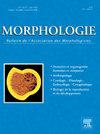Temporomandibular joint disorder: Anatomy of pain (part 1)
Q3 Medicine
引用次数: 0
Abstract
The temporomandibular joint (TMJ) is a complex synovial articulation connecting the mandible to the temporal bone, facilitating essential functions like chewing and speaking through rotational and translational movements. Temporomandibular disorders (TMDs) cause significant pain and dysfunction, often involving myogenous, arthrogenous, or multifactorial etiologies. This review elucidates TMJ anatomy, embryology, and pain pathways, with a focus on central pain mechanisms underlying TMD. Key anatomical components include the mandibular condyle, articular disc, and masticatory muscles, innervated by the mandibular nerve (V3) and vascularized by the maxillary artery. Pain in TMD involves peripheral and central sensitization, modulated by the spinal trigeminal nucleus, thalamus, and somatosensory cortex. This work aims to guide clinicians in evidence-based TMD diagnosis and management, emphasizing multidisciplinary approaches and future research into molecular pain pathways.
颞下颌关节紊乱:疼痛解剖(第一部分)
颞下颌关节(TMJ)是连接下颌骨和颞骨的复杂滑膜关节,通过旋转和平移运动促进咀嚼和说话等基本功能。颞下颌紊乱(TMDs)引起明显的疼痛和功能障碍,通常涉及肌源性、关节源性或多因素病因。本文综述了颞下颌关节的解剖学、胚胎学和疼痛通路,重点讨论了颞下颌关节病的中枢疼痛机制。主要解剖成分包括下颌髁、关节盘和咀嚼肌,由下颌神经(V3)支配,由上颌动脉血管化。TMD的疼痛涉及外周和中枢致敏,由三叉神经脊髓核、丘脑和体感觉皮层调节。本研究旨在指导临床医生基于证据的TMD诊断和管理,强调多学科方法和分子疼痛途径的未来研究。
本文章由计算机程序翻译,如有差异,请以英文原文为准。
求助全文
约1分钟内获得全文
求助全文
来源期刊

Morphologie
Medicine-Anatomy
CiteScore
2.30
自引率
0.00%
发文量
150
审稿时长
25 days
期刊介绍:
Morphologie est une revue universitaire avec une ouverture médicale qui sa adresse aux enseignants, aux étudiants, aux chercheurs et aux cliniciens en anatomie et en morphologie. Vous y trouverez les développements les plus actuels de votre spécialité, en France comme a international. Le objectif de Morphologie est d?offrir des lectures privilégiées sous forme de revues générales, d?articles originaux, de mises au point didactiques et de revues de la littérature, qui permettront notamment aux enseignants de optimiser leurs cours et aux spécialistes d?enrichir leurs connaissances.
 求助内容:
求助内容: 应助结果提醒方式:
应助结果提醒方式:


